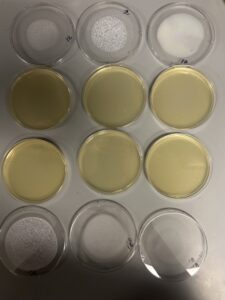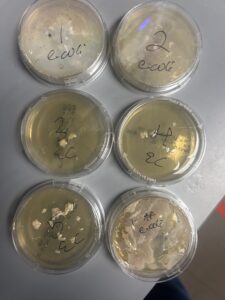Progress in Petri Dishes
Hey gang, we’re back, and the E. coli is thriving! Since the last update, I’ve been focused on scaling up my bacterial cultures to get better plaque visibility. Remember those sad little plates with just 5 plaques? I have now successfully transferred all the E. Coli host plaques to the petri dishes to combine with our MS2 phage. We’ve now upgraded nearly 15 plates for each experimental group- I think we can call this a bacterial glow-up!

To recap: the experiment is designed to test whether equine amniotic fluid has an anti-viral effect on the MS2 bacteriophage, which simulates viral infection, and in this process, E. coli acts as the host. The control group shows what happens when the virus infects bacteria normally, while the experimental group checks if adding amniotic fluid has any effect on the process at all. A third group acts as a negative control, which makes sure the amniotic fluid itself isn’t toxic to the bacteria.

Since the bacterial growth is now consistent, the next step is plating the fully prepped virus-bacteria-fluid combos and letting them incubate. I’ll be keeping an eye on plaque size and number, comparing across all three groups. If the experimental group shows fewer plaques than the control, we may be looking at a real antiviral effect.

What’s also exciting is how this experiment models bigger questions in medicine. Without needing high-security viruses like the bird flu strains or harming animals, I’m learning how natural compounds like amniotic fluid could someday be used to mitigate viral infections—even ones as intense as avian flu. We’re not at breakthrough levels yet, but the data is coming in, and the E. coli are doing their part. For now, I’ll be crunching numbers, photographing plates, and prepping for some comparisons.
Stay tuned for the next update—plaque watch is officially on.

Comments:
All viewpoints are welcome but profane, threatening, disrespectful, or harassing comments will not be tolerated and are subject to moderation up to, and including, full deletion.